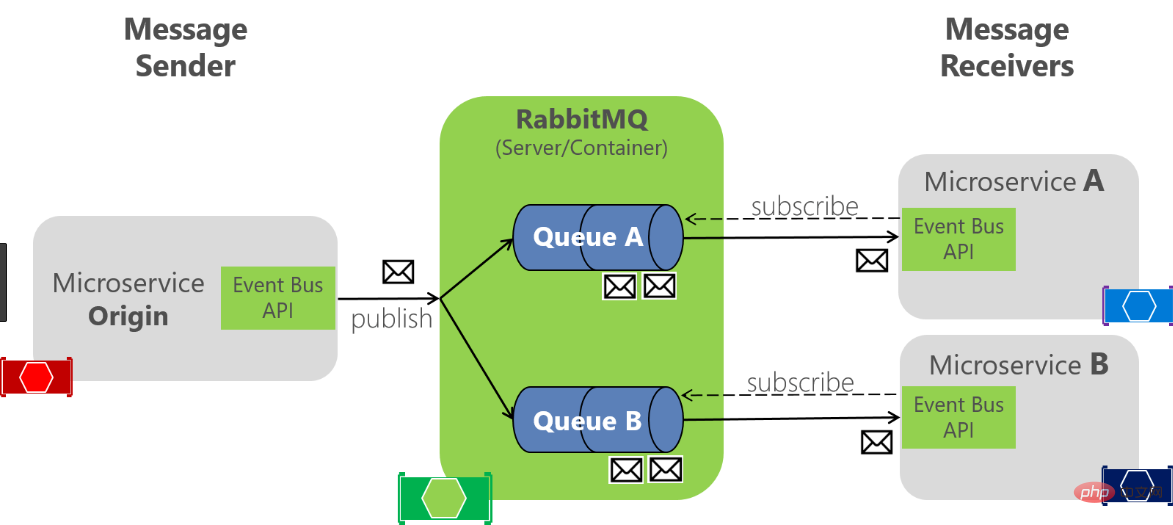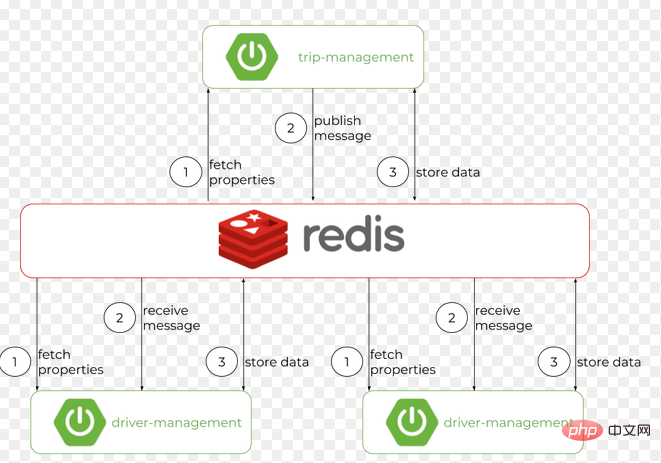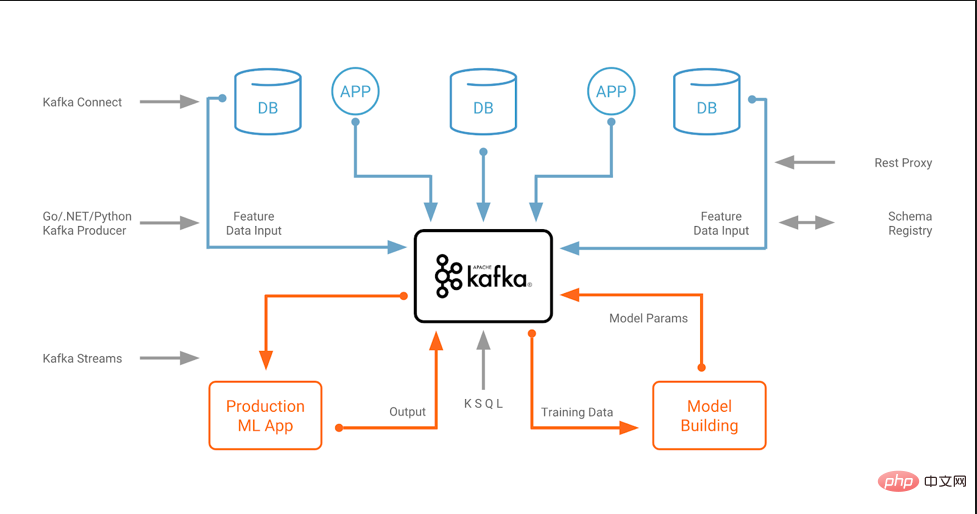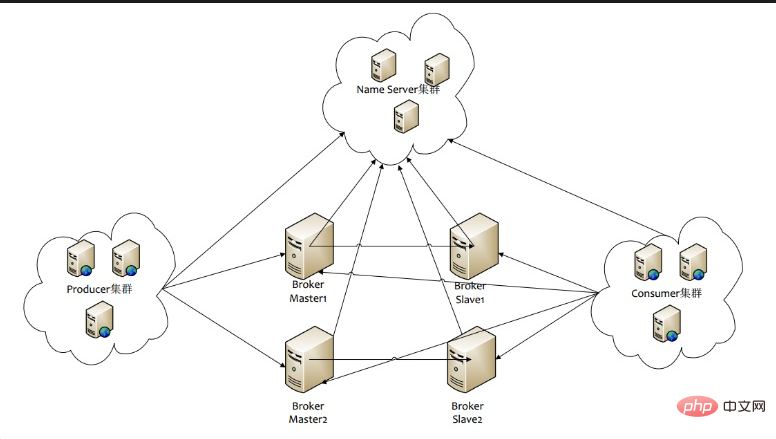Introduction to python's message queue framework

#What are the python message queue frameworks? Here are some useful message queue frameworks:
RabbitMQ
is an open source message queue written in Erlang. It supports many protocols: AMQP, XMPP, SMTP, STOMP. This makes it very heavyweight and more suitable for enterprise-level development. At the same time, a broker (Broker) architecture is implemented, which means that messages are first queued in the central queue when sent to the client. It has good support for routing, load balance or data persistence.

Redis
is a Key-Value NoSQL database. Development and maintenance are very active, although it is a Key-Value database. Storage system, but it itself supports MQ function, so it can be used as a lightweight queue service. For the enqueuing and dequeuing operations of RabbitMQ and Redis, each is executed 1 million times, and the execution time is recorded every 100,000 times. The test data is divided into four different sizes of 128Bytes, 512Bytes, 1K and 10K. Experiments show that when entering the queue, the performance of Redis is higher than that of RabbitMQ when the data is relatively small, but if the data size exceeds 10K, Redis is unbearably slow; when leaving the queue, Redis shows very good performance regardless of the size of the data. , and the dequeue performance of RabbitMQ is much lower than that of Redis.

Related recommendations: "python video tutorial"
ZeroMQ
is known as the most Fast message queue system, especially for large throughput demand scenarios. ZMQ can implement advanced/complex queues that RabbitMQ is not good at, but developers need to combine multiple technical frameworks themselves. The technical complexity is a challenge to the successful application of MQ. ZeroMQ has a unique non-middleware model, you do not need to install and run a message server or middleware, because your application will play this service role. You just need to simply reference the ZeroMQ library, which can be installed using NuGet, and then you can happily send messages between applications. But ZeroMQ only provides non-persistent queues, which means that if the machine goes down, the data will be lost. Among them, Twitter's Storm uses ZeroMQ as the data stream transmission.

ActiveMQ
is a sub-project under Apache. Similar to ZeroMQ, it can implement queues with broker and peer-to-peer technology. At the same time, similar to RabbitMQ, it can efficiently implement advanced application scenarios with a small amount of code. RabbitMQ, ZeroMQ, and ActiveMQ all support commonly used multi-language clients C, Java, .Net, Python, Php, Ruby, etc.

Jafka/Kafka
is a high-performance cross-language distributed Publish/Subscribe message queue system, and Jafka is based on Kafka Incubated above, it is an upgraded version of Kafka. It has the following characteristics: fast persistence, which can persist messages with O(1) system overhead; high throughput, which can reach a throughput rate of 10W/s on an ordinary server; a completely distributed system, Broker , Producer, and Consumer all natively and automatically support distribution and automatically achieve complex balance; support parallel loading of Hadoop data, which is a feasible solution for log data and offline analysis systems like Hadoop that require real-time processing limitations. . Kafka unifies online and offline message processing through Hadoop's parallel loading mechanism, which is also what the system studied in this project values. Apache Kafka is a very lightweight messaging system compared to ActiveMQ. In addition to very good performance, it is also a well-working distributed system.

Rocketmq
RocketMQ is a distributed messaging middleware open sourced by Alibaba in 2012 and has been donated to the Apache Software Foundation. , and became a top-level project of Apache on September 25, 2017. As a domestic middleware that has experienced many "super projects" such as Alibaba's Double Eleven and has achieved stable and outstanding performance, it has been used by more and more people in recent years due to its high performance, low latency and high reliability. used by domestic enterprises.

The above is the detailed content of Introduction to python's message queue framework. For more information, please follow other related articles on the PHP Chinese website!

Hot AI Tools

Undresser.AI Undress
AI-powered app for creating realistic nude photos

AI Clothes Remover
Online AI tool for removing clothes from photos.

Undress AI Tool
Undress images for free

Clothoff.io
AI clothes remover

AI Hentai Generator
Generate AI Hentai for free.

Hot Article

Hot Tools

Notepad++7.3.1
Easy-to-use and free code editor

SublimeText3 Chinese version
Chinese version, very easy to use

Zend Studio 13.0.1
Powerful PHP integrated development environment

Dreamweaver CS6
Visual web development tools

SublimeText3 Mac version
God-level code editing software (SublimeText3)

Hot Topics
 1385
1385
 52
52
 PHP and Python: Code Examples and Comparison
Apr 15, 2025 am 12:07 AM
PHP and Python: Code Examples and Comparison
Apr 15, 2025 am 12:07 AM
PHP and Python have their own advantages and disadvantages, and the choice depends on project needs and personal preferences. 1.PHP is suitable for rapid development and maintenance of large-scale web applications. 2. Python dominates the field of data science and machine learning.
 Python vs. JavaScript: Community, Libraries, and Resources
Apr 15, 2025 am 12:16 AM
Python vs. JavaScript: Community, Libraries, and Resources
Apr 15, 2025 am 12:16 AM
Python and JavaScript have their own advantages and disadvantages in terms of community, libraries and resources. 1) The Python community is friendly and suitable for beginners, but the front-end development resources are not as rich as JavaScript. 2) Python is powerful in data science and machine learning libraries, while JavaScript is better in front-end development libraries and frameworks. 3) Both have rich learning resources, but Python is suitable for starting with official documents, while JavaScript is better with MDNWebDocs. The choice should be based on project needs and personal interests.
 Detailed explanation of docker principle
Apr 14, 2025 pm 11:57 PM
Detailed explanation of docker principle
Apr 14, 2025 pm 11:57 PM
Docker uses Linux kernel features to provide an efficient and isolated application running environment. Its working principle is as follows: 1. The mirror is used as a read-only template, which contains everything you need to run the application; 2. The Union File System (UnionFS) stacks multiple file systems, only storing the differences, saving space and speeding up; 3. The daemon manages the mirrors and containers, and the client uses them for interaction; 4. Namespaces and cgroups implement container isolation and resource limitations; 5. Multiple network modes support container interconnection. Only by understanding these core concepts can you better utilize Docker.
 Python: Automation, Scripting, and Task Management
Apr 16, 2025 am 12:14 AM
Python: Automation, Scripting, and Task Management
Apr 16, 2025 am 12:14 AM
Python excels in automation, scripting, and task management. 1) Automation: File backup is realized through standard libraries such as os and shutil. 2) Script writing: Use the psutil library to monitor system resources. 3) Task management: Use the schedule library to schedule tasks. Python's ease of use and rich library support makes it the preferred tool in these areas.
 How to run programs in terminal vscode
Apr 15, 2025 pm 06:42 PM
How to run programs in terminal vscode
Apr 15, 2025 pm 06:42 PM
In VS Code, you can run the program in the terminal through the following steps: Prepare the code and open the integrated terminal to ensure that the code directory is consistent with the terminal working directory. Select the run command according to the programming language (such as Python's python your_file_name.py) to check whether it runs successfully and resolve errors. Use the debugger to improve debugging efficiency.
 What is vscode What is vscode for?
Apr 15, 2025 pm 06:45 PM
What is vscode What is vscode for?
Apr 15, 2025 pm 06:45 PM
VS Code is the full name Visual Studio Code, which is a free and open source cross-platform code editor and development environment developed by Microsoft. It supports a wide range of programming languages and provides syntax highlighting, code automatic completion, code snippets and smart prompts to improve development efficiency. Through a rich extension ecosystem, users can add extensions to specific needs and languages, such as debuggers, code formatting tools, and Git integrations. VS Code also includes an intuitive debugger that helps quickly find and resolve bugs in your code.
 Can visual studio code be used in python
Apr 15, 2025 pm 08:18 PM
Can visual studio code be used in python
Apr 15, 2025 pm 08:18 PM
VS Code can be used to write Python and provides many features that make it an ideal tool for developing Python applications. It allows users to: install Python extensions to get functions such as code completion, syntax highlighting, and debugging. Use the debugger to track code step by step, find and fix errors. Integrate Git for version control. Use code formatting tools to maintain code consistency. Use the Linting tool to spot potential problems ahead of time.
 Is the vscode extension malicious?
Apr 15, 2025 pm 07:57 PM
Is the vscode extension malicious?
Apr 15, 2025 pm 07:57 PM
VS Code extensions pose malicious risks, such as hiding malicious code, exploiting vulnerabilities, and masturbating as legitimate extensions. Methods to identify malicious extensions include: checking publishers, reading comments, checking code, and installing with caution. Security measures also include: security awareness, good habits, regular updates and antivirus software.




